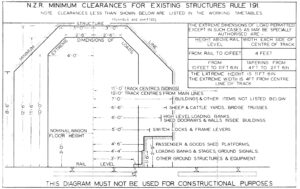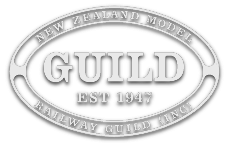In the early days of railways in New Zealand, each province of New Zealand built its own railways. There was no common gauge. The first public railway, from Christchurch to Ferrymead, was built to the broad 5 ft 3 in (1,600 mm) gauge. Railways in Southland and Northland were built to standard gauge of 4 ft 8.5 in (1,435 mm), with plans for standard gauge lines from Auckland to Onehunga and then Drury. In 1870 the central government decreed that all new public railways would be laid to 3 ft 6in (1067mm) and existing railway lines be re-laid to the new standard. At the same time, the central government funded a major public works programme to expand the national railway network, which was one of the reasons for the abolition of the provinces and their individual railway administrations in 1876. Most private railways and some tramways settled on 3’6” as well, but other gauges were in use in various locations.
Our early legislators didn’t realise the problems they would cause when it came to modelling our railways with their use of a narrow gauge. Luckily the combination of HO track and models built to S scale (1:64), gave early modellers the chance to make a start with NZR as 16.5mm (HO gauge) is almost exactly 3’6″. In the early days there was little available, either here or overseas, that was suitable to our needs. As the numbers increased, modellers developed techniques of casting local prototypes in polyester resin, and local manufacture started in the late 1960’s.
Today, there is a thriving local model railway manufacturing industry.
By coincidence, the New Zealand Railways Department’s rolling stock diagram books were drawn to 1:64 and were prize possessions if you could get your hands on one. These planbooks are now in the process of being reproduced as the Cedric Green Series.

What Scale and Gauge?
Many things affect the choice of scale:
- What your peers do (if you want to share running)
- space
- budget
- commercial support
- your goals and standards
Common New Zealand scale and gauge combinations
| Scale | Gauge | Name(s) | Notes |
| 1:34 | 31.5mm (same as G gauge) | 9 mill or NZR P:34 | A large range of castings, both white metal and brass, are available for the scratch builder. Kits in polyester or whitemetal are available for a number of rolling stock items along with a growing number of etched locomotive kits. Click here for a copy of the NZR34 track and wheel standards (P34 standards for NZR track). |
| 1:48 | 22.2mm | NZ48, On3½ and On30 | Click here for the NZMRG NZ48 group. |
| 1:64 | 16.5mm (same as HO/OO gauge) | 3/16 or Sn3½ | The most popular scale/gauge combination for modelling New Zealand’s railways. |
| 1:76 | 16.5mm (same as HO/OO gauge) | NZR OO | Scale of the Frateschi NZR “look alikes” – these models are closer to 1:76 scale or OO gauge model railways. This scale and gauge combination is also popular in Tasmania. Good starting point for beginners. |
| 1:87.1 | 12mm (same as TT gauge) | HO, HOn3½, HOnz, NZ87 | HO gauge is the most popular model railway scale globally, especially in Europe (except Great Britain) and North America. New Zealand following is small but growing. Popular in Australia, especially Queensland, which also the same track gauge as New Zealand. |
| 1:120 | 9mm (same as N gauge) | NZ120, TT9, TTn3½ | NZ120 is the name given to the modelling of New Zealand’s narrow-gauge railways in a scale of 1:120, also known as TT scale. The combination of modelling a prototype track gauge of 3.5 feet (1067mm) in TT scale is also referred to as TTn3.5, or TT9 for the 9mm gauge of the track – the same as standard gauge N scale. |
Other scales modelled include 1:24, 1:43 – 7mm
Dreams and Aspirations
Railway modelling in this country is no different in practice than in any other country. There are modellers who have their own layouts; some just run trains and others run theirs with timetable operation. Likewise, there are those who enjoy building the models while some go to great lengths in their quest for detail. The New Zealand scene is also used as a basis for freelancing. There is no one size fits all.
How, when, where, do I start?
Join the Guild… and learn from the many talented modellers in New Zealand by way of our magazine and enjoy member discounts on the full range of the Guild’s publications.
There is not the space here to tell you exactly how to do it, but in general you should start by reading, learning and planning. There are many excellent magazines available on railway modelling.
Our biannual magazine, The New Zealand Model Railway Journal, focuses on modelling the railways of New Zealand, as well as our weekly online articles in The Journal Online. Other sources of information are railway books – most main libraries have some available – and magazines on full-sized rail practice.
The New Zealand Railway and Locomotive Society Inc. publishes The Observer, a journal of record of NZ railways. They also publish many books and have a large archive in Wellington of the old documents of the New Zealand Government Railways, including photos and drawings.
